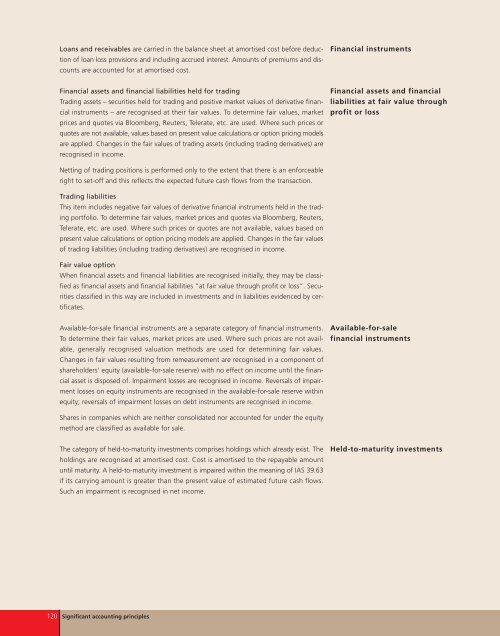team spirit - Bankier.pl
team spirit - Bankier.pl
team spirit - Bankier.pl
Create successful ePaper yourself
Turn your PDF publications into a flip-book with our unique Google optimized e-Paper software.
Loans and receivables are carried in the balance sheet at amortised cost before deduction<br />
of loan loss provisions and including accrued interest. Amounts of premiums and discounts<br />
are accounted for at amortised cost.<br />
Financial assets and financial liabilities held for trading<br />
Trading assets – securities held for trading and positive market values of derivative financial<br />
instruments – are recognised at their fair values. To determine fair values, market<br />
prices and quotes via Bloomberg, Reuters, Telerate, etc. are used. Where such prices or<br />
quotes are not available, values based on present value calculations or option pricing models<br />
are ap<strong>pl</strong>ied. Changes in the fair values of trading assets (including trading derivatives) are<br />
recognised in income.<br />
Netting of trading positions is performed only to the extent that there is an enforceable<br />
right to set-off and this reflects the expected future cash flows from the transaction.<br />
Trading liabilities<br />
This item includes negative fair values of derivative financial instruments held in the trading<br />
portfolio. To determine fair values, market prices and quotes via Bloomberg, Reuters,<br />
Telerate, etc. are used. Where such prices or quotes are not available, values based on<br />
present value calculations or option pricing models are ap<strong>pl</strong>ied. Changes in the fair values<br />
of trading liabilities (including trading derivatives) are recognised in income.<br />
Fair value option<br />
When financial assets and financial liabilities are recognised initially, they may be classified<br />
as financial assets and financial liabilities “at fair value through profit or loss”. Securities<br />
classified in this way are included in investments and in liabilities evidenced by certificates.<br />
Available-for-sale financial instruments are a separate category of financial instruments.<br />
To determine their fair values, market prices are used. Where such prices are not available,<br />
generally recognised valuation methods are used for determining fair values.<br />
Changes in fair values resulting from remeasurement are recognised in a component of<br />
shareholders’ equity (available-for-sale reserve) with no effect on income until the financial<br />
asset is disposed of. Impairment losses are recognised in income. Reversals of impairment<br />
losses on equity instruments are recognised in the available-for-sale reserve within<br />
equity; reversals of impairment losses on debt instruments are recognised in income.<br />
Shares in companies which are neither consolidated nor accounted for under the equity<br />
method are classified as available for sale.<br />
The category of held-to-maturity investments comprises holdings which already exist. The<br />
holdings are recognised at amortised cost. Cost is amortised to the repayable amount<br />
until maturity. A held-to-maturity investment is impaired within the meaning of IAS 39.63<br />
if its carrying amount is greater than the present value of estimated future cash flows.<br />
Such an impairment is recognised in net income.<br />
120 Significant accounting princi<strong>pl</strong>es<br />
Financial instruments<br />
Financial assets and financial<br />
liabilities at fair value through<br />
profit or loss<br />
Available-for-sale<br />
financial instruments<br />
Held-to-maturity investments
















